Page 219 of 522
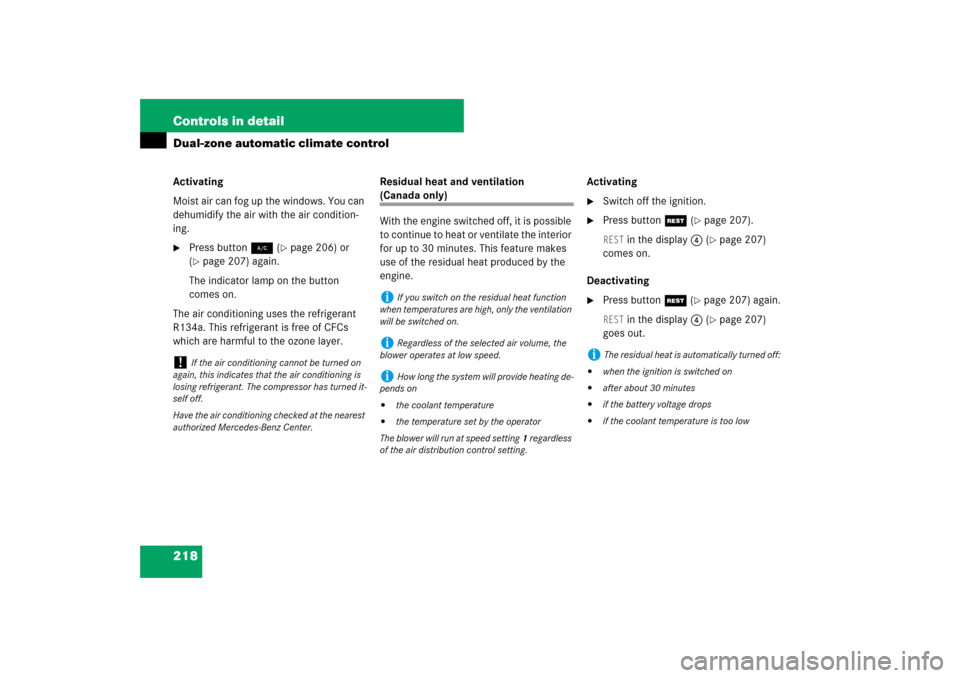
218 Controls in detailDual-zone automatic climate controlActivating
Moist air can fog up the windows. You can
dehumidify the air with the air condition-
ing.�
Press button2 (
�page 206) or
(
�page 207) again.
The indicator lamp on the button
comes on.
The air conditioning uses the refrigerant
R134a. This refrigerant is free of CFCs
which are harmful to the ozone layer.Residual heat and ventilation
(Canada only)
With the engine switched off, it is possible
to continue to heat or ventilate the interior
for up to 30 minutes. This feature makes
use of the residual heat produced by the
engine.Activating
�
Switch off the ignition.
�
Press buttonT (
�page 207).
REST
in the display4 (
�page 207)
comes on.
Deactivating
�
Press buttonT (
�page 207) again.
REST
in the display4 (
�page 207)
goes out.
!
If the air conditioning cannot be turned on
again, this indicates that the air conditioning is
losing refrigerant. The compressor has turned it-
self off.
Have the air conditioning checked at the nearest
authorized Mercedes-Benz Center.
i
If you switch on the residual heat function
when temperatures are high, only the ventilation
will be switched on.
i
Regardless of the selected air volume, the
blower operates at low speed.
i
How long the system will provide heating de-
pends on
�
the coolant temperature
�
the temperature set by the operator
The blower will run at speed setting1 regardless
of the air distribution control setting.
i
The residual heat is automatically turned off:
�
when the ignition is switched on
�
after about 30 minutes
�
if the battery voltage drops
�
if the coolant temperature is too low
Page 235 of 522
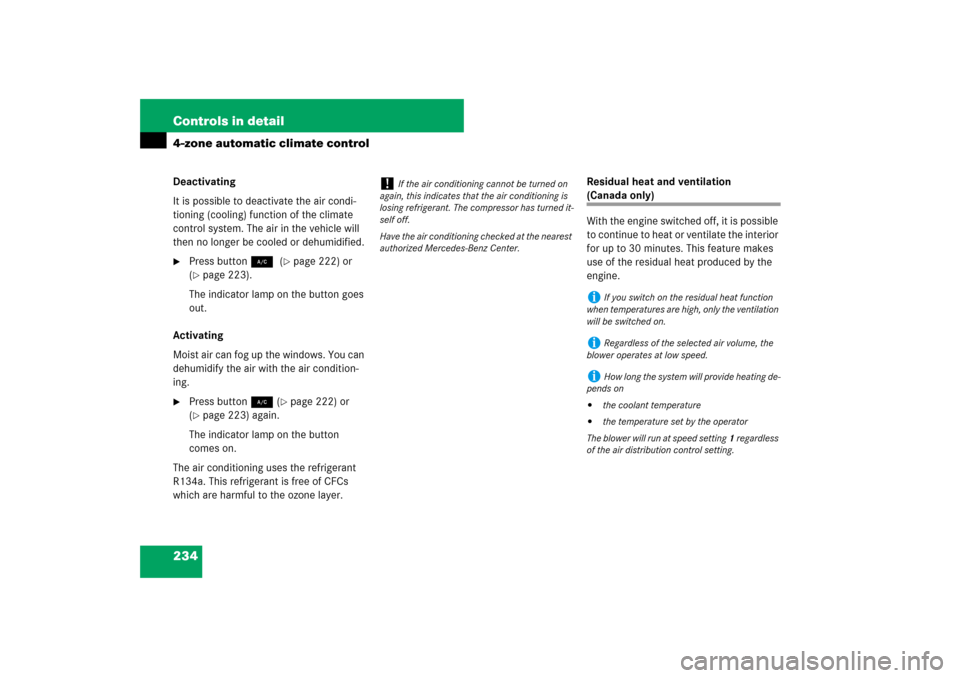
234 Controls in detail4-zone automatic climate controlDeactivating
It is possible to deactivate the air condi-
tioning (cooling) function of the climate
control system. The air in the vehicle will
then no longer be cooled or dehumidified.�
Press button2 (
�page 222) or
(
�page 223).
The indicator lamp on the button goes
out.
Activating
Moist air can fog up the windows. You can
dehumidify the air with the air condition-
ing.
�
Press button2 (
�page 222) or
(
�page 223) again.
The indicator lamp on the button
comes on.
The air conditioning uses the refrigerant
R134a. This refrigerant is free of CFCs
which are harmful to the ozone layer.Residual heat and ventilation
(Canada only)
With the engine switched off, it is possible
to continue to heat or ventilate the interior
for up to 30 minutes. This feature makes
use of the residual heat produced by the
engine.
!
If the air conditioning cannot be turned on
again, this indicates that the air conditioning is
losing refrigerant. The compressor has turned it-
self off.
Have the air conditioning checked at the nearest
authorized Mercedes-Benz Center.
i
If you switch on the residual heat function
when temperatures are high, only the ventilation
will be switched on.
i
Regardless of the selected air volume, the
blower operates at low speed.
i
How long the system will provide heating de-
pends on
�
the coolant temperature
�
the temperature set by the operator
The blower will run at speed setting1 regardless
of the air distribution control setting.
Page 236 of 522
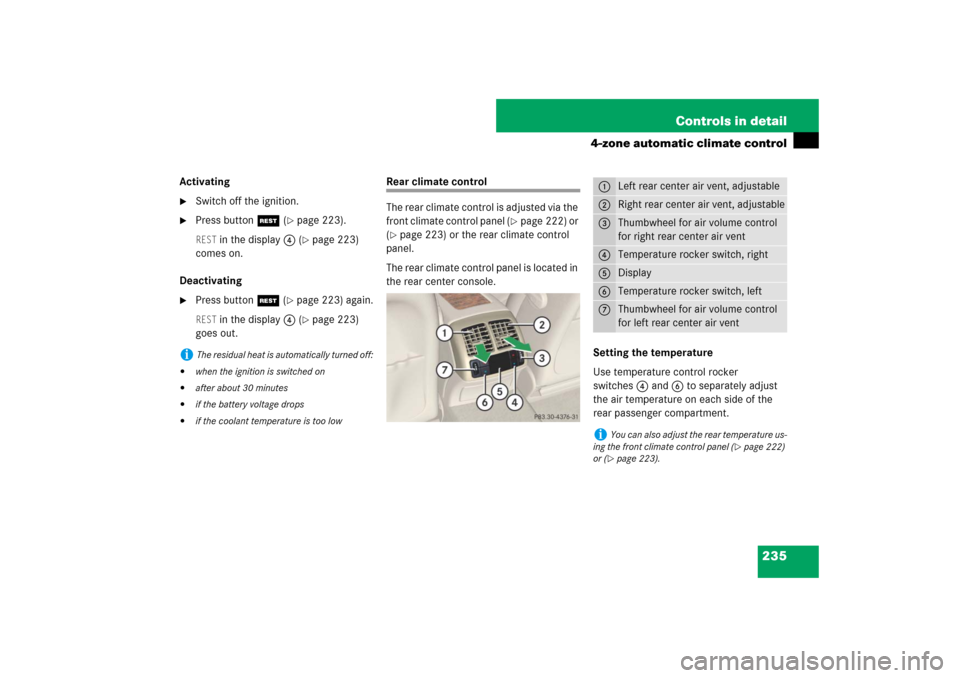
235 Controls in detail
4-zone automatic climate control
Activating�
Switch off the ignition.
�
Press buttonT (
�page 223).
REST
in the display4 (
�page 223)
comes on.
Deactivating
�
Press buttonT (
�page 223) again.
REST
in the display4 (
�page 223)
goes out.
Rear climate control
The rear climate control is adjusted via the
front climate control panel (
�page 222) or
(
�page 223) or the rear climate control
panel.
The rear climate control panel is located in
the rear center console.
Setting the temperature
Use temperature control rocker
switches4 and6 to separately adjust
the air temperature on each side of the
rear passenger compartment.
i
The residual heat is automatically turned off:
�
when the ignition is switched on
�
after about 30 minutes
�
if the battery voltage drops
�
if the coolant temperature is too low
1
Left rear center air vent, adjustable
2
Right rear center air vent, adjustable
3
Thumbwheel for air volume control
for right rear center air vent
4
Temperature rocker switch, right
5
Display
6
Temperature rocker switch, left
7
Thumbwheel for air volume control
for left rear center air vent
i
You can also adjust the rear temperature us-
ing the front climate control panel (
�page 222)
or (
�page 223).
Page 321 of 522
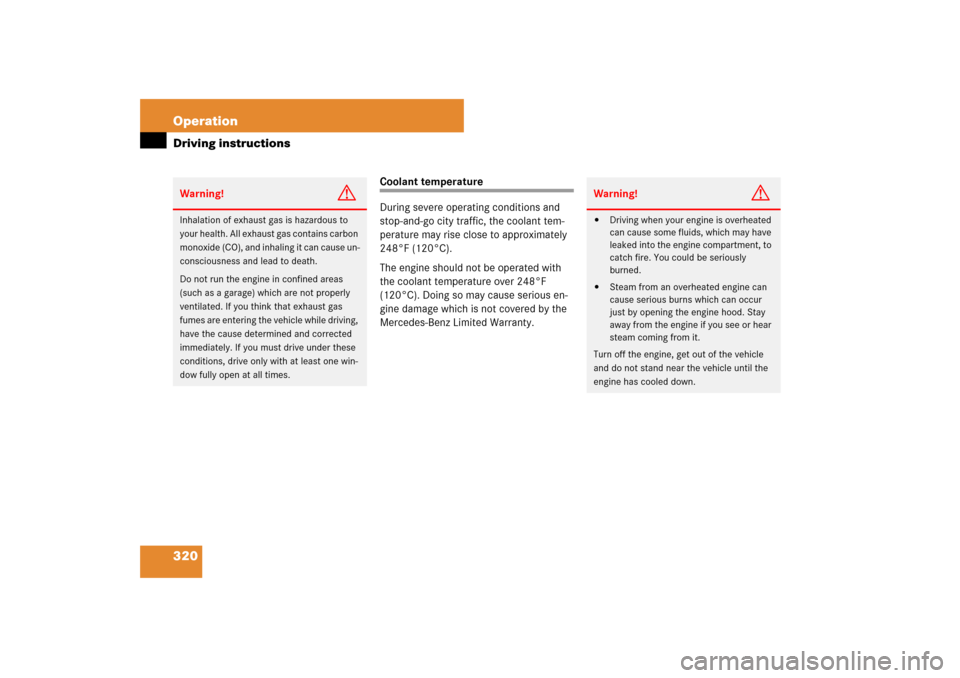
320 OperationDriving instructions
Coolant temperature
During severe operating conditions and
stop-and-go city traffic, the coolant tem-
perature may rise close to approximately
248°F (120°C).
The engine should not be operated with
the coolant temperature over 248°F
(120°C). Doing so may cause serious en-
gine damage which is not covered by the
Mercedes-Benz Limited Warranty.
Warning!
G
Inhalation of exhaust gas is hazardous to
your health. All exhaust gas contains carbon
monoxide (CO), and inhaling it can cause un-
consciousness and lead to death.
Do not run the engine in confined areas
(such as a garage) which are not properly
ventilated. If you think that exhaust gas
fumes are entering the vehicle while driving,
have the cause determined and corrected
immediately. If you must drive under these
conditions, drive only with at least one win-
dow fully open at all times.
Warning!
G
�
Driving when your engine is overheated
can cause some fluids, which may have
leaked into the engine compartment, to
catch fire. You could be seriously
burned.
�
Steam from an overheated engine can
cause serious burns which can occur
just by opening the engine hood. Stay
away from the engine if you see or hear
steam coming from it.
Turn off the engine, get out of the vehicle
and do not stand near the vehicle until the
engine has cooled down.
Page 324 of 522
323 Operation
At the gas station
Low outside temperatures
(diesel engine)
To prevent malfunctions, diesel fuel with
improved cold flow characteristics is of-
fered in the winter months. Check with
your fuel retailer.
Check regularly and before a long trip
1Windshield washer system and head-
lamp cleaning system*
2Brake fluid
3Coolant level
!
Diesel engine:
The engine is more susceptible to wear and
damage if you use
�
marine diesel fuel
�
heating oil
�
additives
The exhaust aftertreatment device will be
seriously damaged if you use
�
LOW SULFUR DIESEL FUEL
(500 ppm SULFUR MAXIMUM)
�
any other diesel fuel with a sulfur content of
above 15 ppm
The use of such non-approved fuels and/or
special additives is not covered by the
Mercedes-Benz Limited Warranty.
!
Do not fill the tank with gasoline. Do not
blend diesel fuel with gasoline or kerosine. The
fuel system and engine will otherwise be dam-
aged, which is not covered by the
Mercedes-Benz Limited Warranty.
Page 325 of 522

324 OperationAt the gas stationWindshield washer system and
headlamp cleaning system*
For information on refilling the reservoir,
see “Windshield washer system and
headlamp cleaning system*”
(�page 332).
Brake fluid
For information on brake fluid, see “Fuels,
coolants, lubricants etc.” (
�page 491).Coolant
For normal replenishing, use water (pota-
ble water quality). For more information on
coolant, see “Coolant level” (
�page 330)
and see “Fuels, coolants, lubricants etc.”
(
�page 491).
Engine oil level
For more information on engine oil level,
see “Engine oil” (
�page 327).Vehicle lighting
Check function and cleanliness. For more
information on replacing light bulbs, see
“Replacing bulbs” (
�page 443).
For more information, see “Exterior lamp
switch” (
�page 137).
Tire inflation pressure
For more information, see “Checking tire
inflation pressure” (
�page 342).
!
If you find that the brake fluid in the brake
fluid reservoir has fallen to the minimum mark or
below, have the brake system checked for brake
pad thickness and leaks immediately. Notify an
authorized Mercedes-Benz Center immediately.
Do not add brake fluid as this will not solve the
problem. For more information, see “Practical
hints” (�page 383).
Page 326 of 522
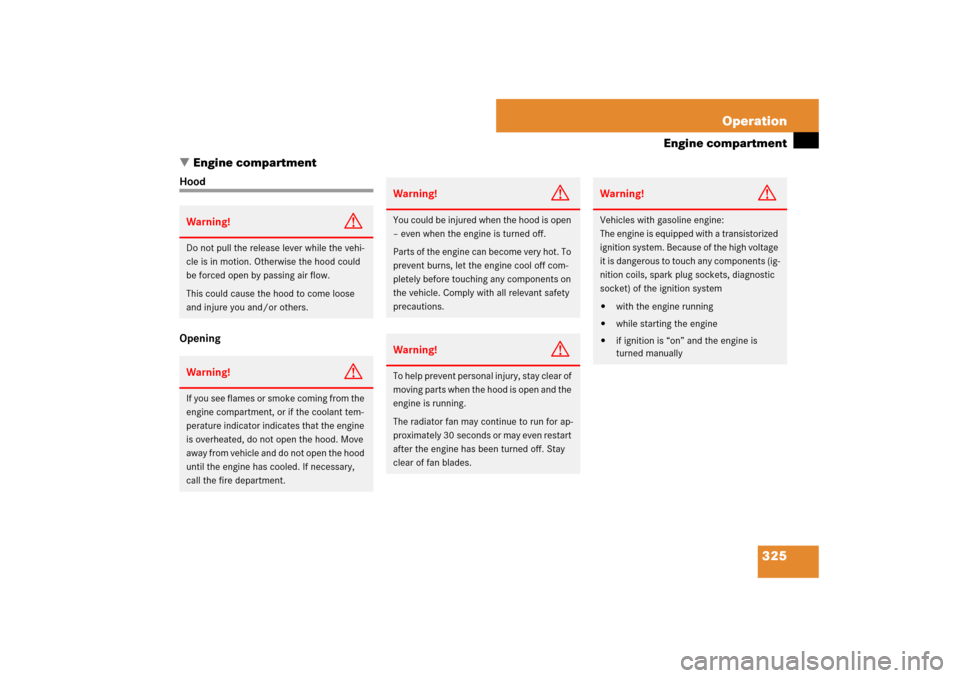
325 Operation
Engine compartment
�Engine compartment
Hood
OpeningWarning!
G
Do not pull the release lever while the vehi-
cle is in motion. Otherwise the hood could
be forced open by passing air flow.
This could cause the hood to come loose
and injure you and/or others.Warning!
G
If you see flames or smoke coming from the
engine compartment, or if the coolant tem-
perature indicator indicates that the engine
is overheated, do not open the hood. Move
away from vehicle and do not open the hood
until the engine has cooled. If necessary,
call the fire department.
Warning!
G
You could be injured when the hood is open
– even when the engine is turned off.
Parts of the engine can become very hot. To
prevent burns, let the engine cool off com-
pletely before touching any components on
the vehicle. Comply with all relevant safety
precautions.Warning!
G
To help prevent personal injury, stay clear of
moving parts when the hood is open and the
engine is running.
The radiator fan may continue to run for ap-
proximately 30 seconds or may even restart
after the engine has been turned off. Stay
clear of fan blades.
Warning!
G
Vehicles with gasoline engine:
The engine is equipped with a transistorized
ignition system. Because of the high voltage
it is dangerous to touch any components (ig-
nition coils, spark plug sockets, diagnostic
socket) of the ignition system�
with the engine running
�
while starting the engine
�
if ignition is “on” and the engine is
turned manually
Page 329 of 522

328 OperationEngine compartmentChecking engine oil level
When checking the oil level�
the vehicle must be parked on level
ground
�
with the engine at operating tempera-
ture, the vehicle must have been sta-
tionary for at least 5 minutes with the
engine turned off
�
with the engine not at operating tem-
perature yet, the vehicle must have
been stationary for at least 5 minutes
with the engine turned off1Oil dipstick
2Upper (max) mark
3Lower (min) mark
To check the engine oil level with the oil
dipstick, do the following:
�
Open the hood (
�page 325).
�
Pull out oil dipstick1.
�
Wipe oil dipstick1 clean.
�
Fully insert oil dipstick1 into the
dipstick guide tube.
�
Pull out oil dipstick1 again after
approximately 3 seconds to obtain ac-
curate reading.
The oil level is correct when it is be-
tween the lower (min) mark3 and
upper (max) mark2 of oil dipstick1.
�
If necessary, add engine oil.
For adding engine oil, see “Adding engine
oil”.
For more information on engine oil, see
“Fuels, coolants, lubricants etc.”
(
�page 491).
For more information on messages in the
multifunction display concerning engine
oil, see the “Practical hints” section
(�page 418).
i
All models (except E 63 AMG):
The filling quantity between the upper and lower
marks on the oil dipstick is approximately
2.1 US qt. (2.0 l).
E63AMG:
The filling quantity between the upper and lower
marks on the oil dipstick is approximately
1.6 US qt. (1.5 l).